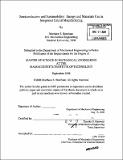| dc.contributor.advisor | Timothy G. Gutowski. | en_US |
| dc.contributor.author | Branham, Matthew S | en_US |
| dc.contributor.other | Massachusetts Institute of Technology. Dept. of Mechanical Engineering. | en_US |
| dc.date.accessioned | 2009-06-30T17:10:32Z | |
| dc.date.available | 2009-06-30T17:10:32Z | |
| dc.date.copyright | 2008 | en_US |
| dc.date.issued | 2008 | en_US |
| dc.identifier.uri | http://hdl.handle.net/1721.1/46056 | |
| dc.description | Thesis (S.M.)--Massachusetts Institute of Technology, Dept. of Mechanical Engineering, 2008. | en_US |
| dc.description | Includes bibliographical references (p. 80-82). | en_US |
| dc.description.abstract | Semiconductors have propelled an incredible revolution in the way we generate, access, store, and communicate information; the effects of this revolution have transformed culture, society, and the economy. At the same time, there have been increasingly portentous signs of the extent to which people are overtaxing their planet and its resources. This study is conducted in the context of both of these upheavals with the goal of better understanding how and how much energy and material are used in semiconductor manufacturing. The results of a case study of the Analog Devices Micromachined Products Division (MPD) fabrication facility are presented in support. In it, energy consumption is examined both from a top-down (fab-level) and bottom-up (equipment-level) perspective. Total fab material use is also presented. We find that the facility currently uses roughly 1.53 kWh of electricity and 35 grams of chemicals per square centimeter of product wafer. Electrical energy consumption is further broken down by facility systems and then by process areas. To give additional insight into the energy and materials intensity of semiconductor manufacturing, results from the monitoring of specific processes are presented. In order to provide structure to the method of evaluating the efficiency of these processes, a thermodynamic model of manufacturing is first introduced. The study concludes with a look at the fundamental reasons why the industry is so energy intensive and changes that Analog Devices could make to reduce their fab's energy intensity. | en_US |
| dc.description.statementofresponsibility | by Matthew S. Branham. | en_US |
| dc.format.extent | 82 p. | en_US |
| dc.language.iso | eng | en_US |
| dc.publisher | Massachusetts Institute of Technology | en_US |
| dc.rights | M.I.T. theses are protected by
copyright. They may be viewed from this source for any purpose, but
reproduction or distribution in any format is prohibited without written
permission. See provided URL for inquiries about permission. | en_US |
| dc.rights.uri | http://dspace.mit.edu/handle/1721.1/7582 | en_US |
| dc.subject | Mechanical Engineering. | en_US |
| dc.title | Semiconductors and sustainability : energy and materials use in integrated circuit manufacturing | en_US |
| dc.type | Thesis | en_US |
| dc.description.degree | S.M. | en_US |
| dc.contributor.department | Massachusetts Institute of Technology. Department of Mechanical Engineering | |
| dc.identifier.oclc | 373849319 | en_US |
